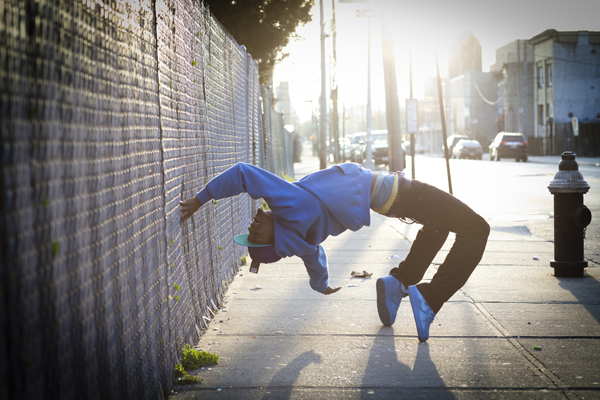In Brooklyn, there’s a dance style known as flexing. Its practitioners claim there are “no rules and no boundaries.” They use everything they can think of—costumes, stunts, masks, and magic tricks—to top each other. A blend of theater and dance, flexing is more Pina Bausch than Breakin’, where one-on-one battles can build to a spectacular finish with blows, known as punch lines. Flex is Kings follows Flizzo, Reem, and Jay Donn as they try to use their moves to find a better life.
This engaging film calls another documentary to mind. David LaChapelle’s Rize was about krumping, a previous dance trend. Krumping is arresting—it looks like nothing else. As such, the impact of Rize unavoidably centers largely on the movement itself, which is strange, unique, and thrilling. But the interest in any trend comes with a shelf life. Flexing is harder to categorize. It involves more individual storytelling, and so its practioners stand out more.
At one point Flizzo visits a magic shop to find inspiration for new punch lines. An employee demonstrates a certain trick, and Flizzo mentions that someone pulled that on him in a previous battle. So he asks for something else. You can’t repeat, he says. This self-imposed pressure to reach higher and higher heights leads to instances of inspired creativity: a punch line involving a live bird must be seen to be believed. One expects that Flizzo’s art will be constantly evolving and consistently exciting.
Another aspect putting the emphasis on the dancers is the absence of much social commentary. Early on, we learn that Jay Donn has been cast in an artsy production of Pinocchio. When he meets the men in charge, it’s like a scene from a tale of two Brooklyns. The white dance/theater artists look like upscale hipsters fresh from central casting; one can almost hear Spike Lee ranting in the background. But gentrification or other issues facing those in the film aren’t really touched on. It seems everyone is working so hard they don’t have time to complain.
This is very nearly a flaw. We see Flizzo winning battles, Jay earning a literal ticket out (to the Edinburgh Festival Fringe), and Reem’s event planning becoming more and more successful. Can one make a compelling documentary when everything is going right for the subjects? That question lives on as trouble creeps in, at least for Flizzo. He and his girlfriend are seen twice at each other’s throats. Dancing, he explains, is only a fleeting joy next to his daily struggles.
It’s not that one desires more adversity in the lives of these men. Some of the highlights are quiet moments of simple happiness. But it is moving to be reminded that flexing serves as a potential escape from both the moment and the wider environment. True, not everyone can use dance to find a way to a better place, but perhaps it can make life better.
That these battles can serve as alternatives to actual armed combat is a theory championed by a number of those interviewed. Audience members even simulate shooting guns whenever a particularly good move lands. One mother of two dancers so believes in the benefits of flexing that she becomes a kind of stage mom, hugging her youngest and then gently chiding, “You have to work on your footwork.”
We can’t yet know what the ultimate punch line may be, but it’s clear from the dancers’ talent and heart that they are fighting a very good fight.







Leave A Comment